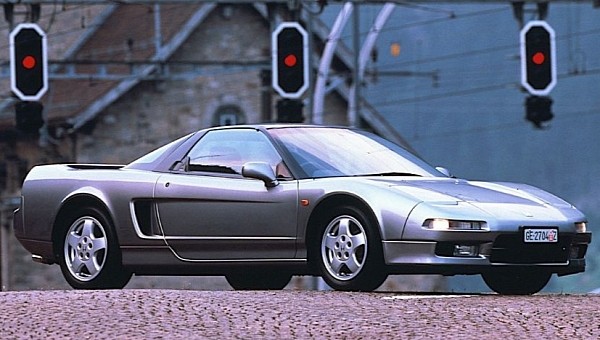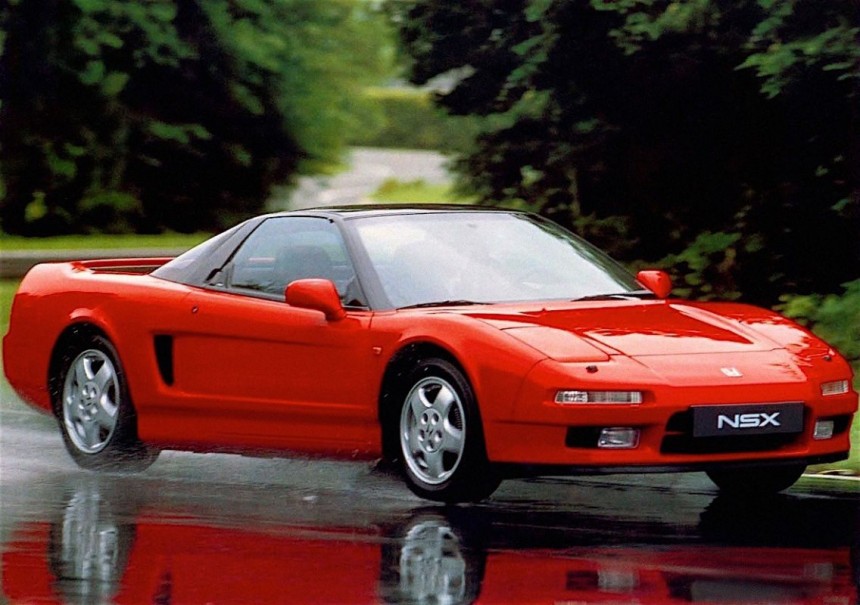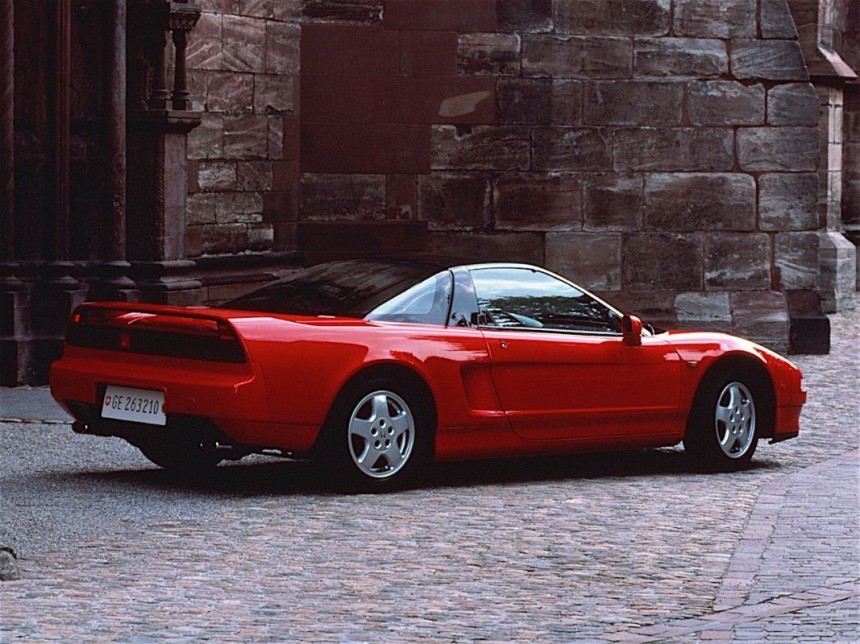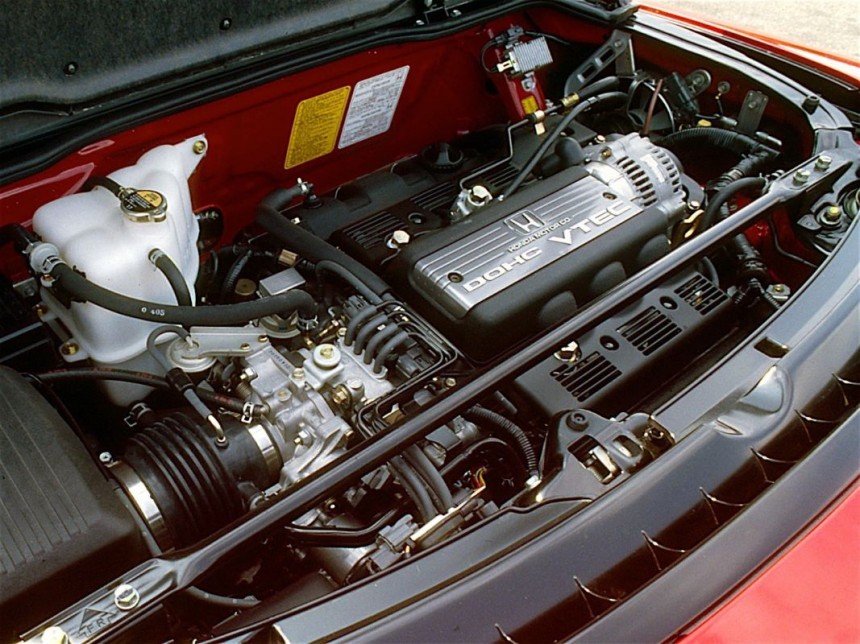In the late 1980s, a supercar meant Ferrari and Lamborghini. You had models like the Testarossa, 328, Countach, and even the Jalpa. Until the 1990s, Italian supercars were fast first, stylish second, and reliable; you can forget that last part. However, Honda came up with something incredible.
In 1990, the most humble car company basically redefined what a supercar was. It set a new standard for performance cars because it created a model that was reliable, affordable, and practical, all while being fast enough to leave a Lamborghini or Ferrari in the rearview mirror. An automobile that let every Italian manufacturer know they were lazy, superficial, and uninspired. We are talking about the Honda NSX, the Japanese sportscar that destroyed supercars. For now, let's go a little back in time.
It's 1983, and back then, Honda was just a brave and bold little economy car brand, creating front-wheel drive cars like CR-X, Prelude, and Civic, which were reliable, cheap, and efficient as humanly possible. Still, they were fun enough to make you feel pretty good. Still, behind the boring city car brand was actually a squad of intelligent, dedicated, and hard-working racing engineers conquering competitions like the Formula 2 in the early 1980s. They had an engine that won in 1981, 1983, and 1984. Honda just needed a car to show the world what they were capable of.
However, until that point, the Japanese car manufacturer hadn't even made a proper sports vehicle. They had no experience whatsoever, but the Japanese engineers started tinkering with engine placements and drive types one day. It would be best if you kept in mind that, until then, they only made front-engined, front-wheel drive cars. As a result, they took a Honda City (one of the least sporty cars ever created by humankind), threw an engine in the back, and took it for a spin around the factory. The workers were immediately blown away.
The handling of this weird creation (something similar to Frankenstein but on wheels) was actually really dynamic, precise, and tight. Honda's squad was ecstatic about the outcome because they finally tasted what it was like to build something special. Seriously, the NSX you know and love today (some of you actually worship the NSX) owes everything to some bored engineers and a Honda City.
Meanwhile, Honda Corporate was preparing the Acura brand for the American market, and they needed a halo car to show the Americans that they had come to conquer. This wasn't just another boring Honda car. In addition, it could have been super easy for the Japanese engineers to take one of their models, make it rear-wheel drive, and tune the engine a bit to have more power. But they said screw that. We are building a freaking supercar. They didn't want to overcome and beat only Nissan, Toyota, or the more luxurious brands like BMW or Mercedes.
They were going for the big dogs, and the objective was to take down Ferrari. The Project Lead, Shigeru Uehara, told the Japanese engineers to create a car that could outperform the Ferrari 328 but make it a Honda. The Japanese automaker didn't make difficult cars; instead, they were building reliable, respectable, and easy-to-drive vehicles, so the same should apply to the sports ones. The base idea was that the Honda supercar should be able to spend a day at a racetrack and drive home in one piece. You should be able to park it on the street, see out of it, go shopping with it and, carry your items of luggage, survive in a crash. So the Honda supercar should be an actual good vehicle.
In contrast, in the 1980s, this is not what Italy was making. Honda's vision of the NSX may seem tame now, but in 1985, they were making history just in a very, very Honda way. They set out to change the world of sports cars with a piece of graph paper. If that sounds weird, let me explain. Uehara and his team plotted out every competitive car on a graph, where they compared all types of statistical pieces of information. Besides that, Honda was building their own Formula 1 engine, working very closely with McLaren.
The NSX would push as close as possible to the Formula 1 balance of power, weight, and dimensions. As a result, it would go beyond what every other sports car and supercar of the time was doing. To create a vehicle as no one else had seen before, Honda needed to do something that was never seen before.
Initially, they struggled to balance the car's weight and power, but inspiration struck while traveling with the fastest train in Japan made of aluminum. Until then, no manufacturer had made an all-aluminum monocoque-body production car. This was the secret and final ingredient to creating a vehicle with reliable power and low weight. Honda revolutionized the use of aluminum in the entire automotive industry. And this is where Honda almost drops the ball completely. Once they have the chassis designed and all the bits ironed out, they put a single-cam Accord engine in it. Yes, an Accord engine. You make an entirely revolutionary new way to manufacture a sports car chassis, launch a whole new luxury brand in the United States, and give it a lazy sedan engine.
The NSX was set to debut at the 1989 Chicago Auto Show. The crowd was stunned and intrigued by what Honda hid behind the curtain. However, the president of the brand revved up the NSX prototype and realized that the car didn't have the new revolutionary VTEC system. As a result, he forced his engineers to develop an entirely new six-cylinder VTEC engine. The 3.0-liter V6 power unit is one of the greatest powerplants, so the decision made was more than impressive. This was the first time the American audience would ever feel VTEC kick in, saving the NSX from becoming DeLorean 2.0, a disappointing supercar.
The NSX featured a variable volume induction system that gave the car an extensive torque curve, allowing the engine to go up to an 8000 rpm redline. In the manual transmission trim, the NSX had a power output of 270 hp (274 PS) with a 0-62 mph (100 kph) time of 5.6 seconds. The top speed was 160 mph (257 kph), which were some impressive numbers for 1990.
Honda had its sights set plainly on Ferrari, with the 328 being the performance baseline. Uehara and his team produced a prototype NSX capable of testing in 1989. With the help of one of the most legendary racing drivers in history, Ayrton Senna, they unlocked the NSX's full potential. The prototype spent an entire month at Suzuka Circuit, pushed to its absolute limits. After a whole month of refining, the engineers were confident they would impress Senna with how the NSX carved an apex. However, the three-time F1 world champion said the car it's a bit fragile, stunning the engineers. Months later, the Honda supercar was back to being 50% stiffer than before. Now the NSX was ready to compete on the world stage.
Honda's $130 million project had paid off. At around $60,000 brand new, the NSX destroyed the other supercars when it came to units sold. Without a doubt, Ferrari and Lamborghini were extremely scared because a car beat them at their own game on its first try for half the cost of a mid-level Ferrari. The NSX was fast, agile, easy to drive and handle, reliable, cheap, and all of the above.
While the numbers aren't the most impressive, especially by today's standards, the NSX was never about that. It was as balanced and sharp as a Swiss watch, and in the right hands, it was as fast as anything the likes of Porsche, Ferrari, or Lamborghini could hope to achieve.
The NSX was one of the most revolutionary cars of all time, helping the automotive industry evolve and changing the mentality of Italian automakers. Besides, it inspired arguably the most incredible supercar of all time, the McLaren F1. While the NSX faded away, it remains the benchmark that inspired and motivated McLaren to create the perfect supercar, Lamborghini to change the look of a supercar with the Diablo, and Ferrari to make more agile and quick cars, such as the 360.
It's 1983, and back then, Honda was just a brave and bold little economy car brand, creating front-wheel drive cars like CR-X, Prelude, and Civic, which were reliable, cheap, and efficient as humanly possible. Still, they were fun enough to make you feel pretty good. Still, behind the boring city car brand was actually a squad of intelligent, dedicated, and hard-working racing engineers conquering competitions like the Formula 2 in the early 1980s. They had an engine that won in 1981, 1983, and 1984. Honda just needed a car to show the world what they were capable of.
However, until that point, the Japanese car manufacturer hadn't even made a proper sports vehicle. They had no experience whatsoever, but the Japanese engineers started tinkering with engine placements and drive types one day. It would be best if you kept in mind that, until then, they only made front-engined, front-wheel drive cars. As a result, they took a Honda City (one of the least sporty cars ever created by humankind), threw an engine in the back, and took it for a spin around the factory. The workers were immediately blown away.
The handling of this weird creation (something similar to Frankenstein but on wheels) was actually really dynamic, precise, and tight. Honda's squad was ecstatic about the outcome because they finally tasted what it was like to build something special. Seriously, the NSX you know and love today (some of you actually worship the NSX) owes everything to some bored engineers and a Honda City.
They were going for the big dogs, and the objective was to take down Ferrari. The Project Lead, Shigeru Uehara, told the Japanese engineers to create a car that could outperform the Ferrari 328 but make it a Honda. The Japanese automaker didn't make difficult cars; instead, they were building reliable, respectable, and easy-to-drive vehicles, so the same should apply to the sports ones. The base idea was that the Honda supercar should be able to spend a day at a racetrack and drive home in one piece. You should be able to park it on the street, see out of it, go shopping with it and, carry your items of luggage, survive in a crash. So the Honda supercar should be an actual good vehicle.
In contrast, in the 1980s, this is not what Italy was making. Honda's vision of the NSX may seem tame now, but in 1985, they were making history just in a very, very Honda way. They set out to change the world of sports cars with a piece of graph paper. If that sounds weird, let me explain. Uehara and his team plotted out every competitive car on a graph, where they compared all types of statistical pieces of information. Besides that, Honda was building their own Formula 1 engine, working very closely with McLaren.
The NSX would push as close as possible to the Formula 1 balance of power, weight, and dimensions. As a result, it would go beyond what every other sports car and supercar of the time was doing. To create a vehicle as no one else had seen before, Honda needed to do something that was never seen before.
The NSX was set to debut at the 1989 Chicago Auto Show. The crowd was stunned and intrigued by what Honda hid behind the curtain. However, the president of the brand revved up the NSX prototype and realized that the car didn't have the new revolutionary VTEC system. As a result, he forced his engineers to develop an entirely new six-cylinder VTEC engine. The 3.0-liter V6 power unit is one of the greatest powerplants, so the decision made was more than impressive. This was the first time the American audience would ever feel VTEC kick in, saving the NSX from becoming DeLorean 2.0, a disappointing supercar.
The NSX featured a variable volume induction system that gave the car an extensive torque curve, allowing the engine to go up to an 8000 rpm redline. In the manual transmission trim, the NSX had a power output of 270 hp (274 PS) with a 0-62 mph (100 kph) time of 5.6 seconds. The top speed was 160 mph (257 kph), which were some impressive numbers for 1990.
Honda had its sights set plainly on Ferrari, with the 328 being the performance baseline. Uehara and his team produced a prototype NSX capable of testing in 1989. With the help of one of the most legendary racing drivers in history, Ayrton Senna, they unlocked the NSX's full potential. The prototype spent an entire month at Suzuka Circuit, pushed to its absolute limits. After a whole month of refining, the engineers were confident they would impress Senna with how the NSX carved an apex. However, the three-time F1 world champion said the car it's a bit fragile, stunning the engineers. Months later, the Honda supercar was back to being 50% stiffer than before. Now the NSX was ready to compete on the world stage.
While the numbers aren't the most impressive, especially by today's standards, the NSX was never about that. It was as balanced and sharp as a Swiss watch, and in the right hands, it was as fast as anything the likes of Porsche, Ferrari, or Lamborghini could hope to achieve.
The NSX was one of the most revolutionary cars of all time, helping the automotive industry evolve and changing the mentality of Italian automakers. Besides, it inspired arguably the most incredible supercar of all time, the McLaren F1. While the NSX faded away, it remains the benchmark that inspired and motivated McLaren to create the perfect supercar, Lamborghini to change the look of a supercar with the Diablo, and Ferrari to make more agile and quick cars, such as the 360.























